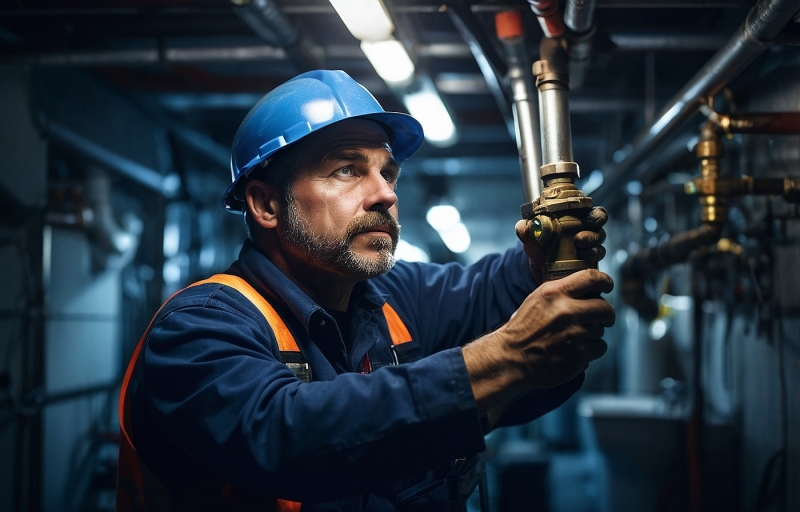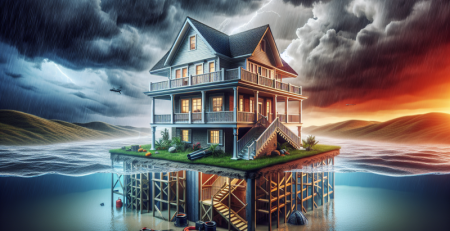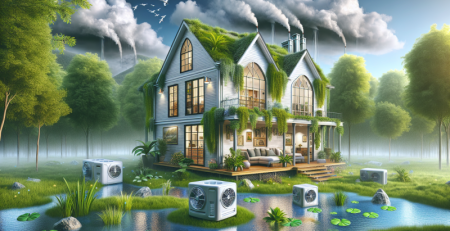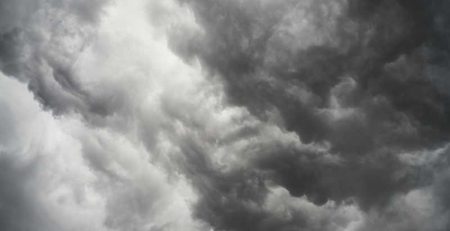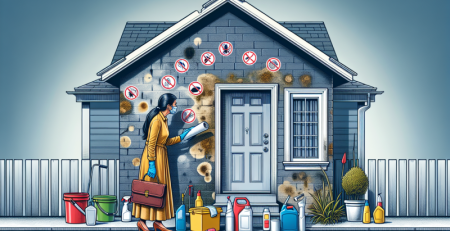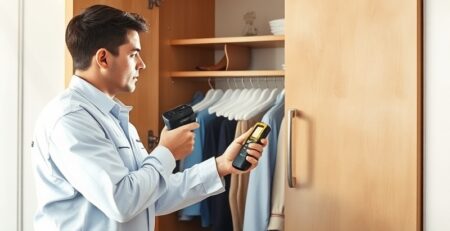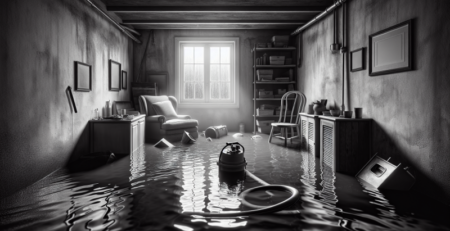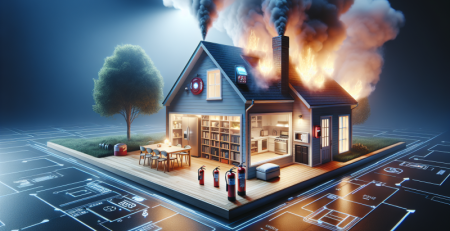Water Damage: How to Prevent Burst Pipes in Winter
Winter can be tough on your home’s plumbing, and without proper precautions, freezing temperatures can lead to burst pipes and costly water damage. When water inside your pipes freezes, it expands, creating pressure that can cause pipes to crack or burst, leading to flooding, structural damage, and mold growth. Preventing burst pipes in winter is essential to protecting your home and avoiding expensive repairs. At Kraus Restoration, we specialize in water damage restoration and provide 24/7 emergency services across Central and Northern NJ. Our IICRC-certified experts respond quickly to minimize damage and restore your property. In this guide, we’ll share expert tips on how to prevent frozen pipes, safeguard your plumbing, and avoid winter water damage. If you’re dealing with a burst pipe, call us at (973) 886-2021 for immediate assistance.
Understanding the Risks of Burst Pipes in Winter
Winter brings picturesque snowfall and cozy nights by the fire, but it also presents serious risks to homeowners, particularly when it comes to burst pipes. As temperatures drop, water inside pipes can freeze, expand, and create immense pressure, leading to cracks or complete ruptures. This can result in extensive water damage, costly repairs, and potential health hazards from mold growth. Understanding the risks associated with burst pipes in winter is crucial for homeowners looking to protect their property and avoid unnecessary expenses.
One of the primary reasons pipes burst in winter is the freezing and expansion of water. According to the Insurance Institute for Business & Home Safety, a one-eighth-inch crack in a pipe can release up to 250 gallons of water per day, causing significant structural damage and mold growth. Pipes in unheated areas such as basements, attics, garages, and exterior walls are particularly vulnerable. When water freezes, it expands by approximately 9 percent, increasing pressure within the pipes and leading to potential ruptures.
Older homes with outdated plumbing systems are at a higher risk of experiencing burst pipes. Corroded or weakened pipes are more susceptible to damage when exposed to freezing temperatures. Additionally, homes with poor insulation or inadequate heating systems may struggle to maintain a consistent indoor temperature, increasing the likelihood of frozen pipes.
Another critical factor contributing to burst pipes is sudden temperature fluctuations. When temperatures drop rapidly, pipes may not have enough time to adjust, leading to thermal stress and cracks. This is especially common in regions that experience extreme winter weather conditions.
The financial impact of burst pipes can be staggering. According to the Insurance Information Institute, water damage and freezing account for nearly 29 percent of all homeowner insurance claims in the United States, with the average claim costing around $10,900. These costs include not only plumbing repairs but also damage to flooring, walls, furniture, and personal belongings.
Beyond financial concerns, burst pipes can lead to serious health risks. Standing water from a burst pipe creates the perfect environment for mold and mildew growth, which can cause respiratory issues, allergies, and other health problems. If not addressed promptly, mold can spread throughout the home, requiring professional mold cleanup services to ensure a safe living environment.
To illustrate the severity of burst pipes, consider the following real-life examples:
- In 2021, Texas experienced an unprecedented winter storm that caused widespread pipe bursts due to prolonged freezing temperatures. Thousands of homes and businesses suffered extensive water damage, leading to billions of dollars in insurance claims and repairs.
- A homeowner in Chicago faced a burst pipe in their attic, resulting in water cascading down through multiple floors. The damage required extensive restoration, including replacing drywall, flooring, and insulation.
- A commercial property in New York experienced a burst pipe in its sprinkler system, flooding multiple office spaces and disrupting business operations for weeks.
Preventing burst pipes requires proactive measures such as insulating pipes, maintaining a consistent indoor temperature, and allowing faucets to drip during extreme cold spells. Homeowners should also be aware of their main water shut-off valve location to minimize damage in case of a pipe burst.
For those who experience water damage due to burst pipes, seeking professional assistance is essential. Companies specializing in restoration services can help mitigate damage, remove excess water, and restore affected areas efficiently.
For more information on preventing and addressing water damage, visit reputable sources such as:
- Insurance Information Institute – Preventing and Handling Water Damage
- American Red Cross – Preventing Frozen Pipes
- Environmental Protection Agency – Water Conservation Tips
By understanding the risks of burst pipes in winter and taking preventive measures, homeowners can safeguard their property, reduce repair costs, and ensure a safe and comfortable living environment throughout the colder months.
Why Freezing Temperatures Cause Pipes to Burst
During winter, freezing temperatures pose a significant risk to plumbing systems, often leading to burst pipes and extensive water damage. When the temperature drops, the water inside pipes begins to freeze, expanding as it turns into ice. This expansion creates immense pressure within the pipe, especially in areas where water is trapped between a closed faucet and a frozen section. As the pressure builds, the pipe material weakens, eventually leading to cracks or complete ruptures. The most vulnerable pipes are those located in unheated areas such as basements, attics, garages, and exterior walls. Poor insulation and exposure to cold air further increase the likelihood of freezing. Once a pipe bursts, the thawing ice releases a sudden rush of water, causing flooding and potential structural damage. Homeowners and business owners must take preventive measures to avoid such disasters, including insulating pipes, sealing gaps that allow cold air to enter, and keeping a steady flow of water during extreme cold. If a pipe does burst, immediate action is necessary to minimize damage. Professional water cleanup services can help mitigate the impact and restore affected areas. Understanding the science behind freezing pipes is essential for effective prevention. Regular maintenance and timely inspections can significantly reduce the risk of winter-related plumbing issues. For expert assistance, consider reaching out to a trusted restoration company that specializes in water damage repair. Taking proactive steps can save property owners from costly repairs and ensure a safe, damage-free winter season.
Identifying Vulnerable Pipes in Your Home
Identifying the vulnerable pipes in your home is crucial to preventing costly water damage during the winter months. Pipes that are most at risk of freezing and bursting are typically located in unheated areas such as basements, crawl spaces, attics, garages, and exterior walls. These pipes are exposed to colder temperatures and, without proper insulation, can freeze quickly when the temperature drops. Additionally, pipes running through poorly insulated walls or near drafty windows and doors are also susceptible to freezing. It is essential to inspect these areas and take preventive measures before winter arrives. Look for signs of vulnerability, such as pipes with little to no insulation, cracks in walls or foundations that allow cold air to seep in, and pipes that have frozen in previous winters. Homes with older plumbing systems may also have a higher risk of pipe bursts due to corrosion or weakened materials. If you are unsure about the condition of your plumbing, consider reaching out to a professional for an inspection. Proper insulation, sealing gaps, and maintaining a consistent indoor temperature can help protect your pipes from freezing. If you experience water damage due to a burst pipe, seeking professional water cleanup services can help mitigate further damage. Additionally, if moisture buildup leads to mold growth, professional mold cleanup services may be necessary to restore a safe living environment. Taking proactive steps to identify and protect vulnerable pipes can save you from expensive repairs and extensive property damage during the winter season. If you need expert assistance, do not hesitate to contact professionals who specialize in water damage prevention and restoration.
Insulating Pipes to Prevent Freezing
One of the most effective ways to prevent burst pipes in winter is by insulating them properly. When temperatures drop, unprotected pipes are at risk of freezing, which can lead to cracks and costly water damage. Insulation helps maintain a stable temperature within the pipes, reducing the chances of freezing and bursting. There are various insulation materials available, such as foam pipe sleeves, fiberglass, and even heat tape, all of which provide a protective barrier against extreme cold. Pipes located in unheated areas like basements, attics, garages, and crawl spaces are particularly vulnerable and should be prioritized for insulation. Additionally, sealing any gaps or cracks in walls and floors near pipes can further prevent cold air from affecting them. Homeowners should also consider insulating outdoor pipes and hose bibs to prevent freezing. Proper insulation not only protects pipes but also improves energy efficiency by reducing heat loss. If you are unsure about the best insulation method for your home, consulting a professional can help ensure your pipes are adequately protected. For expert assistance in safeguarding your home from water damage, explore our services or reach out through our contact page. Taking proactive measures now can save you from expensive repairs and potential disruptions caused by burst pipes in the winter months.
Keeping a Consistent Indoor Temperature
Maintaining a stable indoor temperature is crucial in preventing pipes from freezing and bursting during winter. When temperatures drop, water inside pipes can freeze, expand, and create immense pressure, leading to cracks or complete pipe failure. To avoid this costly and disruptive issue, homeowners should keep their indoor temperature consistent, even when they are away. Setting the thermostat to at least 55°F (13°C) ensures that pipes remain warm enough to prevent freezing. Additionally, opening cabinet doors under sinks allows warm air to circulate around plumbing, reducing the risk of cold spots. Sealing gaps and cracks around windows, doors, and walls also helps maintain a steady indoor climate, preventing cold drafts from affecting exposed pipes. Insulating pipes in unheated areas such as basements, attics, and garages further enhances protection against freezing temperatures. Smart thermostats can be a valuable investment, allowing homeowners to monitor and adjust indoor temperatures remotely. If a home is left vacant for an extended period, shutting off the main water supply and draining the pipes can prevent potential water damage. In case of unexpected pipe bursts, immediate action is necessary to minimize damage. Professional water cleanup services can help restore affected areas and prevent further complications. For those seeking expert assistance in safeguarding their homes, exploring available services can provide valuable solutions. If you need personalized guidance, do not hesitate to contact professionals who specialize in water damage prevention and restoration.
Letting Faucets Drip to Relieve Pressure
One simple yet effective way to prevent pipes from bursting during winter is by allowing faucets to drip slightly. When temperatures drop significantly, the water inside pipes can freeze, causing an increase in pressure that may lead to cracks or bursts. By letting a faucet drip, you keep the water moving, which reduces the chances of freezing and relieves built-up pressure within the plumbing system. This method is particularly useful for pipes located along exterior walls or in unheated areas such as basements, attics, and garages. Even a slow trickle of water can make a significant difference in preventing costly water damage. Additionally, it is advisable to open both hot and cold taps slightly, as this helps maintain a balanced flow and prevents freezing in both supply lines. If you are unsure about which faucets to leave dripping, consulting a professional can provide valuable guidance. In case of water damage, immediate action is crucial to minimize the impact. Professional water cleanup services can help restore affected areas and prevent further complications. Homeowners should also consider insulating exposed pipes and sealing any gaps or cracks in walls to keep cold air from reaching plumbing lines. If you need expert assistance in protecting your home from winter-related damages, do not hesitate to contact professionals who specialize in water damage prevention and restoration. Taking proactive measures, such as letting faucets drip, can save you from expensive repairs and ensure your plumbing system remains intact throughout the winter season.
Sealing Leaks and Cracks in Your Home
One of the most effective ways to prevent burst pipes in winter is by sealing leaks and cracks in your home. Even small gaps in walls, floors, and foundations can allow cold air to seep in, increasing the risk of frozen pipes. Inspect your home thoroughly, paying close attention to areas where pipes run through walls, basements, and crawl spaces. Use weatherstripping and caulk to seal any visible cracks around windows, doors, and vents. Expanding foam insulation is also a great option for filling larger gaps, especially in areas where pipes are exposed to the elements. Additionally, check for leaks around plumbing fixtures and repair them promptly to prevent moisture buildup, which can weaken pipe materials over time. Insulating exposed pipes with foam pipe sleeves or heat tape can provide an extra layer of protection against freezing temperatures. If you are unsure about the best sealing techniques for your home, consider reaching out to professionals who specialize in water damage restoration. They can assess your home’s vulnerabilities and recommend effective solutions to keep your pipes safe throughout the winter. Properly sealing leaks and cracks not only helps prevent frozen pipes but also improves energy efficiency by reducing heat loss. If you need expert assistance, do not hesitate to contact a trusted restoration service to safeguard your home from potential water damage.
Properly Draining Outdoor Faucets and Hoses
One of the most overlooked yet crucial steps in preventing burst pipes during winter is properly draining outdoor faucets and hoses. When temperatures drop, any water left inside these fixtures can freeze, expand, and cause significant damage. To avoid costly repairs and potential water damage, it is essential to take preventive measures before winter arrives. Start by disconnecting all garden hoses from outdoor faucets. Even if the faucet is frost-proof, a connected hose can trap water inside, increasing the risk of freezing. Once the hose is removed, drain any remaining water by holding it upright and coiling it loosely to prevent kinks. Store hoses indoors or in a shed to protect them from harsh winter conditions. Next, turn off the water supply to outdoor faucets if they have a dedicated shutoff valve. After shutting off the supply, open the faucet to allow any trapped water to drain completely. Leaving the faucet open ensures that any residual water can expand without causing pressure buildup in the pipes. If your outdoor faucet does not have a shutoff valve, consider installing one to provide better protection against freezing temperatures. Additionally, installing insulated faucet covers can add an extra layer of protection. These covers help retain heat and prevent cold air from reaching the faucet, reducing the likelihood of freezing. For homeowners with an irrigation system, it is equally important to drain and winterize the system. Shut off the main water supply to the irrigation system and use compressed air to blow out any remaining water from the pipes. This step prevents water from freezing inside the system, which could lead to cracks and leaks. Taking these precautions can save you from the hassle of dealing with burst pipes and extensive water damage. If you suspect any issues with your plumbing system, it is advisable to seek professional assistance. At Kraus Restoration, we specialize in water damage restoration and can help mitigate any problems caused by frozen or burst pipes. Our team is equipped to handle emergency situations and provide effective solutions to protect your home. For more information about our services, feel free to reach out to us. Proper maintenance and timely precautions can go a long way in ensuring your plumbing system remains intact throughout the winter season. If you need expert advice or assistance, do not hesitate to contact our team for professional support.
Using Pipe Heating Cables for Extra Protection
One of the most effective ways to prevent pipes from freezing and bursting during winter is by using pipe heating cables. These cables provide an extra layer of protection by maintaining a consistent temperature along the length of the pipe, preventing ice formation even in extremely cold conditions. Pipe heating cables are particularly useful for exposed pipes in basements, crawl spaces, attics, and outdoor areas where insulation alone may not be sufficient. They are designed to activate automatically when temperatures drop to a certain level, ensuring that water continues to flow freely. Installing these cables is a cost-effective solution compared to the potential expenses of repairing water damage caused by burst pipes. Homeowners can choose from self-regulating or constant wattage heating cables, depending on their specific needs. Self-regulating cables adjust their heat output based on the surrounding temperature, making them energy-efficient and safe for long-term use. Proper installation is crucial to ensure the effectiveness of heating cables, and it is recommended to follow manufacturer guidelines or seek professional assistance. Regular maintenance, such as checking for wear and tear, ensures that the cables function optimally throughout the winter season. In addition to using heating cables, homeowners should also consider other preventive measures, such as insulating pipes and sealing any gaps where cold air can enter. Taking these precautions can significantly reduce the risk of water damage and costly repairs. If you need expert advice on protecting your home from winter-related damage, explore our services to find the right solution. Our team specializes in addressing water damage and providing effective restoration solutions. For more information about our expertise, visit our about page or check out our recent projects to see how we have helped homeowners safeguard their properties.
Knowing When to Shut Off Your Water Supply
One of the most effective ways to prevent extensive water damage during winter is knowing when and how to shut off your water supply. When temperatures drop significantly, pipes can freeze and eventually burst, leading to costly repairs and potential structural damage. If you notice reduced water pressure, unusual noises from your plumbing, or visible frost on exposed pipes, these could be warning signs that your pipes are at risk of freezing. In such cases, shutting off the main water supply can prevent further damage. Additionally, if you plan to be away from home for an extended period during winter, turning off the water supply and draining the pipes can help avoid unexpected leaks or bursts. Homeowners should also familiarize themselves with the location of the main shut-off valve, which is typically found in the basement, crawl space, or near the water meter. Regular maintenance and inspections can further reduce the risk of frozen pipes. If you experience water damage due to a burst pipe, seeking professional assistance for water cleanup is crucial to prevent mold growth and structural issues. For expert guidance on protecting your home from water damage, explore our services or reach out through our contact page.
What to Do If Your Pipes Freeze
If you discover that your pipes have frozen, it is crucial to act quickly to prevent them from bursting and causing extensive water damage. The first step is to identify which pipes are affected by checking for reduced or no water flow from faucets. Once you have located the frozen section, keep the faucet open to allow water to flow as the ice melts. Applying gentle heat to the frozen pipe can help thaw it safely. You can use a hairdryer, heating pad, or warm towels wrapped around the pipe. Avoid using open flames or high-heat devices, as they can damage the pipes and create a fire hazard. If the frozen pipe is behind a wall, turning up the thermostat or using a space heater in the affected area may help. In cases where you cannot locate the frozen section or if the pipe has already burst, it is essential to shut off the main water supply immediately to prevent further damage. Contacting a professional for assistance is highly recommended to ensure the issue is resolved safely and effectively. If water damage has already occurred, seeking expert help for water cleanup can prevent further complications such as mold growth and structural issues. Preventative measures, such as insulating exposed pipes and keeping cabinets open to allow warm air circulation, can help reduce the risk of freezing in the future. If you need professional guidance or emergency assistance, do not hesitate to contact a trusted restoration service to protect your home from further damage.
Signs of a Burst Pipe and Immediate Actions to Take
A burst pipe can cause significant water damage to your home, especially during winter when freezing temperatures put immense pressure on your plumbing system. Recognizing the signs of a burst pipe early can help minimize damage and prevent costly repairs. One of the most obvious indicators is a sudden drop in water pressure. If you notice weak water flow from faucets or showers, it could be due to a pipe rupture. Another common sign is unusual noises such as banging, whistling, or gurgling sounds coming from your pipes, which may indicate trapped air or water escaping through a crack. Additionally, visible water stains on walls, ceilings, or floors suggest that water is leaking from a hidden pipe. Puddles or damp spots in unexpected areas, especially under sinks or near appliances, are also red flags. If you detect a musty odor, it could mean that water has been leaking for some time, leading to mold growth. In such cases, seeking professional mold cleanup services is crucial to prevent health hazards.
If you suspect a burst pipe, taking immediate action can help mitigate damage. First, shut off the main water supply to prevent further flooding. Locate the main shutoff valve, typically found in the basement, garage, or near the water meter, and turn it off. Next, drain the remaining water from your plumbing system by opening all faucets and flushing toilets. This step helps relieve pressure and minimizes additional leaks. If the burst pipe is near electrical outlets or appliances, turn off the electricity in the affected area to avoid potential hazards. Use towels, buckets, or a wet vacuum to remove standing water and prevent it from seeping into floors and walls. If the damage is extensive, contacting a professional water cleanup service is essential to restore your home and prevent further complications. Additionally, document the damage by taking photos and videos, as this will be helpful when filing an insurance claim. Once the immediate risks are addressed, reach out to a professional plumber to repair or replace the damaged pipe. If you need expert assistance, do not hesitate to contact a restoration specialist to assess the situation and provide the necessary repairs. Taking swift action can prevent structural damage, mold growth, and costly repairs, ensuring your home remains safe and secure throughout the winter months.
Long-Term Strategies for Preventing Water Damage
Preventing water damage in the long term requires a proactive approach that includes regular maintenance, insulation, and monitoring of your plumbing system. One of the most effective ways to prevent burst pipes in winter is to ensure that your pipes are well-insulated, especially those in unheated areas such as basements, attics, and crawl spaces. Insulation sleeves or heat tape can help maintain a stable temperature and reduce the risk of freezing. Additionally, sealing any cracks or openings in walls and foundations can prevent cold air from reaching your pipes. Regularly inspecting your plumbing system for leaks and corrosion is another crucial step in preventing water damage. Small leaks can quickly escalate into major issues if left unaddressed, leading to costly repairs. Homeowners should also consider installing a smart water leak detection system that can alert them to potential leaks before they cause significant damage. Keeping a consistent indoor temperature, even when away from home, can also help prevent pipes from freezing. Setting the thermostat to at least 55 degrees Fahrenheit ensures that the plumbing system remains warm enough to prevent freezing. Another long-term strategy is to schedule routine maintenance with professional restoration experts who can assess the condition of your plumbing system and recommend necessary upgrades. If you experience water damage despite these precautions, seeking professional assistance from water cleanup specialists can help mitigate the damage and restore your property efficiently. Additionally, addressing any mold growth that may result from water damage is essential to maintaining a healthy indoor environment. Professional mold cleanup services can help eliminate harmful mold spores and prevent further damage to your home. Investing in high-quality plumbing materials and fixtures can also contribute to long-term water damage prevention. Choosing durable pipes and fittings reduces the likelihood of leaks and bursts, ensuring the longevity of your plumbing system. Homeowners should also be mindful of their water usage habits, as excessive pressure on pipes can lead to wear and tear over time. Installing a pressure regulator can help maintain a safe water pressure level and prevent unnecessary strain on your plumbing system. If you need expert advice or assistance with water damage prevention, do not hesitate to contact professionals who specialize in restoration services. By implementing these long-term strategies, homeowners can protect their properties from costly water damage and ensure a safe and comfortable living environment.
When to Call a Professional for Help
If you suspect water damage in your home due to burst pipes, knowing when to call a professional can save you time, money, and stress. While minor leaks might be manageable with DIY solutions, significant water damage requires expert intervention. If you notice persistent damp spots on walls, ceilings, or floors, it could indicate hidden leaks that need immediate attention. A sudden drop in water pressure or discolored water from your taps may also signal pipe damage. Additionally, if you detect a musty odor or see mold growth, it is crucial to seek professional help, as mold can pose serious health risks. Water damage can weaken your home’s structure, leading to costly repairs if not addressed promptly. Professionals have the expertise and equipment to assess the extent of the damage and provide effective solutions. If you experience a major pipe burst, shutting off the main water supply and contacting a professional immediately can prevent further damage. Experts in water cleanup can efficiently remove excess moisture, preventing mold growth and structural deterioration. If your home has already suffered extensive damage, consulting a team experienced in residential design can help restore your space to its original condition. For businesses facing water damage, professionals specializing in commercial design can ensure a safe and functional environment. Do not wait until the damage worsens; reaching out to experts at the right time can save your property from long-term issues.
FAQ: Water Damage – How to Prevent Burst Pipes in Winter
1. Why do pipes burst in winter?
Pipes burst in winter due to freezing temperatures. When water inside the pipes freezes, it expands, increasing pressure within the pipe. If the pressure becomes too high, the pipe can crack or burst, leading to water damage.
2. How can I prevent my pipes from freezing?
To prevent pipes from freezing, you can:
- Insulate exposed pipes, especially in unheated areas like basements, attics, and garages.
- Keep cabinet doors open to allow warm air to circulate around pipes.
- Let faucets drip slightly to keep water moving.
- Maintain a consistent indoor temperature, even when away.
- Seal any cracks or gaps in walls to prevent cold air from reaching pipes.
3. Should I leave my faucets dripping?
Yes, letting faucets drip slightly can help prevent freezing. Moving water is less likely to freeze, and it relieves pressure inside the pipes, reducing the risk of bursting.
4. What temperature should I keep my home at to prevent frozen pipes?
It’s recommended to keep your home at least 55°F (13°C), even if you’re away. This helps ensure that pipes remain warm enough to prevent freezing.
5. How do I thaw a frozen pipe safely?
If you suspect a pipe is frozen, you can:
- Apply gentle heat using a hairdryer, heating pad, or warm towels.
- Keep the faucet open to allow water to flow as the ice melts.
- Avoid using open flames or high-heat devices, as they can damage pipes.
6. What should I do if a pipe bursts?
If a pipe bursts, follow these steps:
- Shut off the main water supply immediately.
- Turn off electricity in affected areas if water is near electrical outlets.
- Drain the remaining water by opening faucets.
- Contact a plumber for repairs.
- Begin drying the area to prevent mold and further damage.
7. Can outdoor pipes freeze too?
Yes, outdoor pipes, such as hose bibs and sprinkler lines, are especially vulnerable. To protect them:
- Disconnect and drain garden hoses before winter.
- Shut off outdoor water supply lines and drain them.
- Use insulated faucet covers for extra protection.
8. Does homeowners insurance cover burst pipes?
Most homeowners insurance policies cover water damage from burst pipes if it’s sudden and accidental. However, damage caused by neglect (e.g., failing to maintain heating) may not be covered. Check your policy for details.
9. How can I tell if a pipe is frozen?
Signs of a frozen pipe include:
- No water or only a trickle coming from faucets.
- Frost on exposed pipes.
- Strange smells from drains (caused by blocked pipes).
10. When should I call a plumber?
Call a plumber if:
- You suspect a pipe is frozen but can’t locate or thaw it.
- A pipe has burst and caused water damage.
- You notice persistent leaks or weak water pressure after thawing a pipe.
By taking preventive measures and knowing what to do in case of an emergency, you can protect your home from costly water damage this winter. Stay prepared and stay warm!
